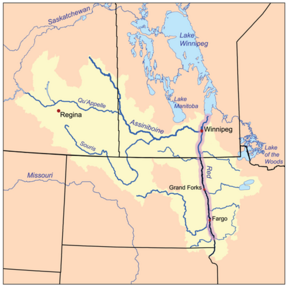Red River of the North
| Red River of the North | |
|---|---|
 |
|
| Origin | confluence of the Bois de Sioux River and Otter Tail River |
| Mouth | Lake Winnipeg |
| Basin countries | United States, Canada |
| Length | 550 mi (885 km) |
| Basin area | 287,500 km² (111,004 sq mi)[1] |
The Red River (French: rivière Rouge) is a North American river. Formed by the confluence of the Bois de Sioux and Otter Tail rivers in the United States, it flows northward through the Red River Valley and forms the border between the U.S. states of Minnesota and North Dakota before continuing into Manitoba, Canada. At its mouth the river flows into Lake Winnipeg. The Red River flows through several major urban areas along its path including Fargo-Moorhead and Greater Grand Forks in the United States and Winnipeg in Canada. The Red is about 550 miles (885 km) long.[2] The US portion is 395 miles (636 km) long and the Canadian portion is 155 miles (249 km).[3] The river falls 70 metres (230 ft) on its trip to Lake Winnipeg where it spreads into the vast deltaic wetland known as Netley Marsh. In the United States, the Red River is sometimes called the Red River of the North which helps to distinguish it from the other Red River which is a tributary of the Mississippi River that forms part of the border between Texas and Oklahoma. In Canada, the Red has been designated as a Canadian Heritage River.
Contents[hide] |
Geography

Along its course, the Red River flows across the flat, fertile flood plain of the ancient glacial Lake Agassiz. The Red River forms at Wahpeton, North Dakota and Breckenridge, Minnesota, passes through Fargo, North Dakota/Moorhead, Minnesota and Grand Forks, North Dakota/East Grand Forks, Minnesota, and then continues on to the province of Manitoba in Canada. Manitoba's capital — Winnipeg — is at the Red's confluence with the Assiniboine River, at a point commonly referred to as The Forks. The Red then flows further north before draining into Lake Winnipeg which is part of the Hudson Bay watershed.
Southern Manitoba has a fairly long frost-free season, consisting of between 120 and 140 days in the Red River Valley. This decreases to the northeast.[4]
History

Originally part of Rupert's Land, the Red was a key river in the early settlement of Canada, a centre of the fur trade and the Métis people, and the site of the Red River Colony — the primary settlement of which eventually became Winnipeg, Manitoba.
The River is well known for flooding in spring due to snow runoff, and has been a topic of "paleoflood" study.[5] Although only three major floods are generally talked about since Europeans have settled in the area, in 1826, 1950 and 1997, there have been many other floods of equal size and even larger ones that can be studied due to their effects on the local landforms.[6]
1950 flood
On May 8, 1950 the Red River reached its highest level since 1861. Eight dikes protecting Winnipeg gave way and flooded much of the city, turning 600 square miles (1,554 km2) of farmland into an enormous lake. The city turned to the Canadian Army and the Red Cross for help, and nearly 70,000 people were evacuated from their homes and businesses (which was one of the largest in Canadian history). Four of eleven bridges in the city were destroyed, and damage was estimated at between $600 million and $1 billion.
As a result of the floods, a flood control project was started to ensure the same would never happen again. The Red River Floodway was cause for some derision at the time, as it seemed massively overbuilt and was the largest earth-moving project in the world at the time. The project was completed under-budget, and has been used for at least some flood control twenty times in the thirty-seven years from its completion to 2006. The Floodway has saved an estimated $10 billion (CAD) in flood damages.
Notes
- ↑ Atlas of Canada. "Rivers of Canada". Retrieved on 2008-08-02.
- ↑ Red River of the North, Minnsota DNR
- ↑ Red River Map 3, Minnesota DNR; map shows the international border at river mile 155.
- ↑ Microsoft ® Encarta ® Encyclopedia 2005 © 1993-2004 Microsoft Corporation. All rights reserved. Retrieved on: October 18, 2008.
- ↑ Paleofloods in the Red River Basin
- ↑ Major Historical Floods in the Red River Basin